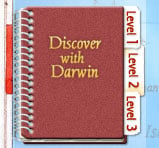QUESTION QUEST
Take a nature walk with a friend for about half an hour. Carry notebooks
with you, and jot down notes and sketches about interesting plants,
animals, and rock formations you see along the way. Don’t talk
during this time. At the end, sit together with your notes and share
the information. Work together to see if you can brainstorm five interesting
research questions that you are really curious about. Don’t
worry about finding the answers yet. Some of the most intriguing questions
that inspire scientists today have yet to be answered. BIODIVERSITY
PUZZLER
Find a local state park or nature preserve in your area. Use a camera
to capture close-up images of ten different objects. If you don't
have one, borrow a camera from a friend or buy a disposable camera
for this project. To find interesting images, try looking at different
levels: on the ground, on the branches of trees, under rocks, even
near garbage cans. Never touch anything that you think might be
dangerous. Keep a notebook about what objects you’ve photographed.
Then, once the film is developed (or if it’s a digital camera,
once the pictures are printed out), create a poster that has a matching
game on it. Use a big piece of paper or poster board and on one
side paste the photos; on the other side write clues. Invite a friend
to try your matching game.
A NATURE TREASURE MAP
Pick a small human-made object that would normally not be found
in nature, such as a brightly colored plastic toy animal or an old
shoe. Then hide the small object in a woodsy area. Write down as
many details as you can about where the object is located (you wouldn’t
want to lose it!) then walk away from the hidden object for a few
minutes to a "Starting Place" that you pick. Draw a treasure
map and write about five clues to help another person find the hidden
object. Make sure the treasure map tells what object is hidden.
Each clue should involve a description of a type of tree or plant.
Then challenge a friend to use your map to find the hidden object.
If your friend has trouble finding the object, give some hints that
point your friend in the right direction. To make it extra interesting,
you can use a field guide to help identify the names of the plants
and to write vivid clues.
FOSSIL HUNT!
Anyone can find fossils. As you probably know, fossils are the remains
of ancient plants and animals — their bones, teeth, shells, stems,
or even footprints. An important key to finding fossils is knowing
where to look. Any old rock won’t do. Most fossils are found
in sedimentary rock. When tiny bits of rocks and minerals (called
sediment) join together over millions of years, they become sedimentary
rock. Plants and animals that become sandwiched in this sediment
eventually turn into fossils. In order to be a fossil hunter, you
need to be patient and persistent.
Some
Important Dos and Don’ts of Fossil Hunting
To help you find out where to search for fossils in your area, check
out the Web sites on Finding
Fossils.
TAKE ACTION
When Darwin visited the Galápagos Islands in 1835, there
were probably around 250,000 giant tortoises there. Today, there
are only about 15,000 of them left. What happened? Many of the tortoises
were hunted extensively for food, or had much fewer babies grow
to adulthood because introduced species such as pigs and dogs ate
their eggs, young, or vegetarian food sources. But fortunately things
are looking up for these rare animals. Thanks to conservation efforts
on the islands, the Galápagos giant tortoise is starting
to make a comeback. Laws have been passed to prevent the capture,
harming, and exportation of giant tortoises. Scientists at the Charles
Darwin Foundation are also raising Galápagos giant tortoises,
so they can mature in a safe environment before they are released
into the wild.
Would you like to help endangered animal species in your area?
An excellent place to get ideas is the Kids page of the U.S.
Fish and Wildlife Service. Also, check out the President's
Environmental Youth Awards.
ZOOM IN
Imagine this! There's a highly sophisticated scientific invention
capable of capturing the world around you in incredible detail.
It's not expensive and it never runs out of batteries. Have a guess?
It's not a computer or even a camera. Here's one more hint: it's
how Charles Darwin recorded the detailed information during his
trip on the Beagle that helped him shape his scientific
theories for the rest of his life. It's a Naturalist Sketch Book
and it's a great way to observe and find patterns in nature. Grab
a pad of paper and some colored pencils and head out to your backyard
or to a local park. Make sketches of the shape of leaves, the color
of birds, and the details on squishy bugs. Then, take it one step
further and check a nature guidebook out of your local library.
See how many of your sketches you can identify.
|





